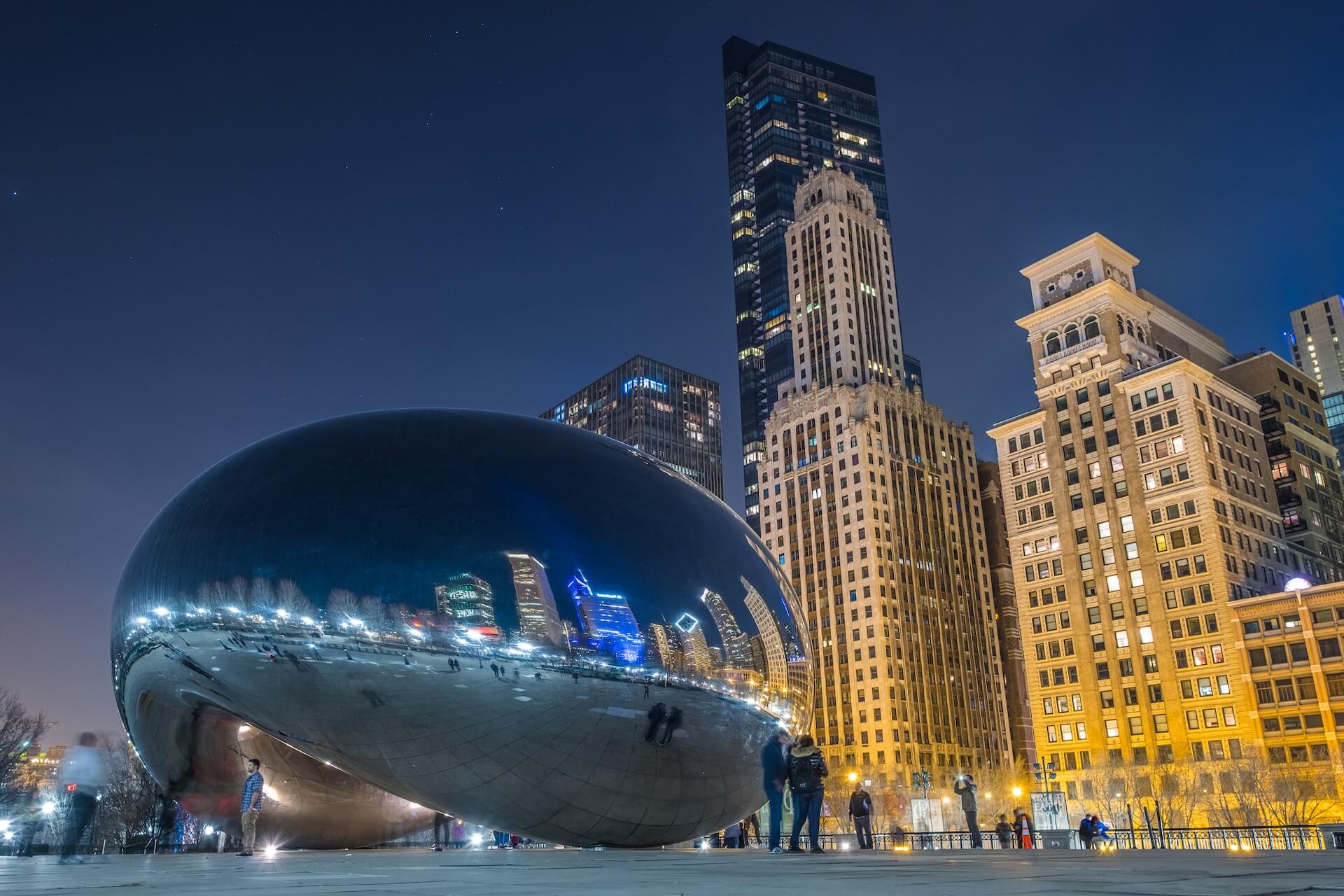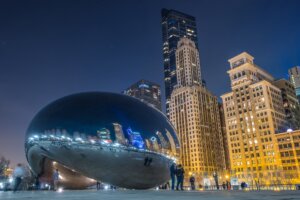
Are you looking for ideas for your trip to Chicago, Illinois? Or are you a local wanting to plan a day out in the city? No visit to Chicago would be complete without seeing Anish Kapoor’s Cloud Gate. Most people commonly call it “The Bean” or sometimes “The Chicago Bean,” despite the artist’s disapproval of the nickname.
This massive art installation has become a landmark in the city, and people come from around the world to see it and touch its surface. While this sculpture has only been around for a short time, you might be curious about its history and origins. Read below as the team at Pequod’s Pizza shares a few details about The Bean.
Where Is The Bean in Chicago?

Image by Lance Anderson is licensed with Unsplash License
You’ll find The Bean in Chicago’s Millennium Park. The park is downtown, and locals refer to it as the “front lawn” because of its green spaces and location right on Lake Michigan. Although the park has many large art installations scattered throughout its 24.5 acres, The Bean is probably the most famous and photographed piece. Its reflective quality lets you see yourself and the Chicago skyline on its mirror-like surface.
If you want to get a selfie of your reflection in The Bean, head to Grainger Plaza, formerly known as AT&T Plaza. You’ll find The Bean here, and it’s also a great spot to view the ice rink in McCormick Tribune Plaza during winter months. The sculpture sits directly behind the Park Grill, the only full-service restaurant in the park. Millennium Park is open from 6 a.m. to 11 p.m. daily, and you can view and photograph The Bean for free. If you’re a commercial photographer, you’ll need permission from the city and the artist before taking pictures.
When Was The Chicago Bean Built?
Anish Kapoor started construction on Cloud Gate in 2004 when Millennium Park first opened to the public. But it took until 2006 for him to complete the sculpture. Before he even finished it, the citizens of Chicago had already dubbed the artwork “The Bean” based on conceptual drawings circulated to the city’s residents. Chicagoans were skeptical of the piece at first, but since its unveiling, it’s become a part of the city. It’s Anish Kapoor’s first publicly displayed sculpture in the United States, and it cost private donors $23 million to complete, which exceeded the originally proposed $6 million.
So many visitors touch the reflective surface of The Chicago Bean each day that a crew polishes the lower 6 feet of its pristine surface up to seven times a day. And they polish the entire sculpture from top to bottom twice a day, in the morning and at night, to ensure you can see it in its best light.
What’s Inside The Chicago Bean?
The smooth, reflective surface of The Chicago Bean entices visitors to touch it, but it may leave you wondering what’s inside the impressive structure. Although Anish Kapoor doesn’t usually rely on computer technology for his designs, the complex nature of The Bean required him to do so. It took two years to complete and was a feat of engineering because of its unique shape and massive size. Inside, The Bean has two steel rings that help it keep its shape. These were the first pieces of the structure put into place.
Once the rings were installed, a metal frame made of steel pipe trusses that crisscross between them was added. This helps the 110-ton sculpture maintain its structural integrity. The Bean is one of the world’s largest permanent outdoor art installations, so the ceiling of the Park Grill restaurant below had to hold its weight. Fortunately, because the site is where the railroad used to run along the lake, the old rail lines help support its incredible weight.
After putting the rings and frame together, the engineering team added the exterior. The Bean comprises 168 stainless steel plates that attach to the frame with flexible connectors, so it expands and contracts as the weather changes. The engineers welded each plate together seamlessly and then polished them to create a smooth, reflective surface, according to the artist’s instructions. The sculpture reaches 33 feet up into the sky, stretches over 66 feet, and spans 42 feet in width. The arch is 12 feet high, and visitors love to walk underneath it to look up at this awe-inspiring artistic feat.
What Does The Chicago Bean Mean?
Many recognize Anish Kapoor for his geometric designs, and he’s been working with highly reflective surfaces in his art since the ’90s. But what does The Bean mean? Liquid mercury inspired its shape and material, and Kapoor wanted the sculpture’s highly reflective surface to show the city’s movement. With people, traffic, and lights constantly moving and changing across its surface, The Bean, although staying motionless, seems to move with the city. Even its shape gives the sense that the art installation is a drop of liquid ready to slip away at any moment.
The Bean was chosen from 30 submissions from artists who wanted their sculptures to appear in Millennium Park. Kapoor’s sculpture made it into the final round along with another competitor. His design was finally selected, but soon after, many wondered if it was the right choice. Some thought it would be impossible to complete because of its massive size, and others worried that the metal surface would get too hot in the summer and too cold in the winter.
Those of us who live in Chicago and the millions of visitors who stop by to get a photo of this landmark are certainly happy that Kapoor and all those involved made it happen.
Well, that’s the history of The Chicago Bean. We hope you find the sculpture as interesting as we do. Have you touched The Bean or explored Millennium Park? If you come to Chicago to see this amazing work of art and feat of engineering, stop by Pequod’s Pizza and try a slice with our famous caramelized crust. We’re sure you won’t be disappointed with your meal or your Chicago experience.